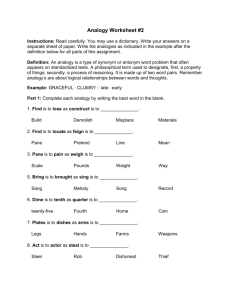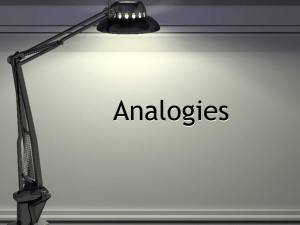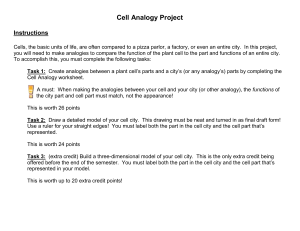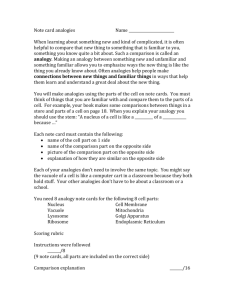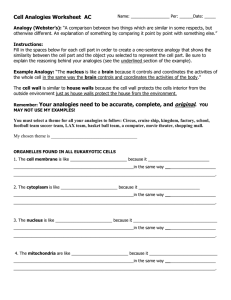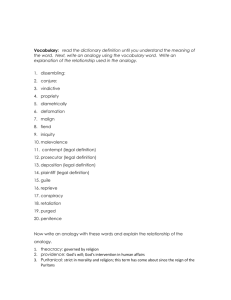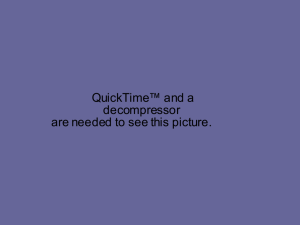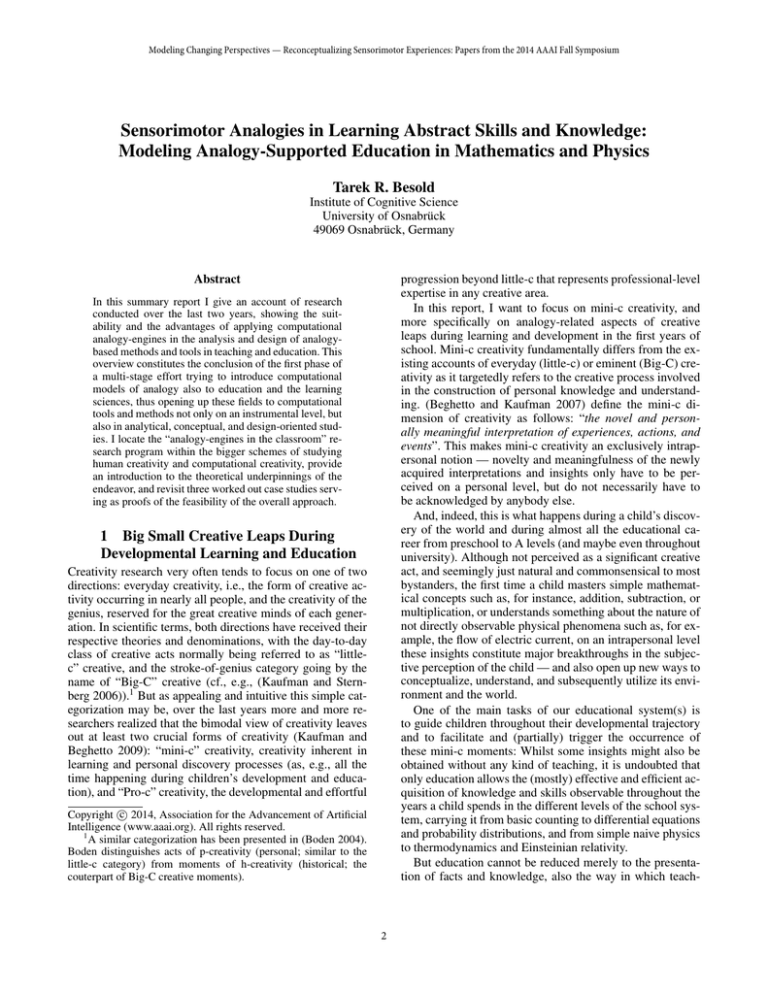
Modeling Changing Perspectives — Reconceptualizing Sensorimotor Experiences: Papers from the 2014 AAAI Fall Symposium
Sensorimotor Analogies in Learning Abstract Skills and Knowledge:
Modeling Analogy-Supported Education in Mathematics and Physics
Tarek R. Besold
Institute of Cognitive Science
University of Osnabrück
49069 Osnabrück, Germany
Abstract
progression beyond little-c that represents professional-level
expertise in any creative area.
In this report, I want to focus on mini-c creativity, and
more specifically on analogy-related aspects of creative
leaps during learning and development in the first years of
school. Mini-c creativity fundamentally differs from the existing accounts of everyday (little-c) or eminent (Big-C) creativity as it targetedly refers to the creative process involved
in the construction of personal knowledge and understanding. (Beghetto and Kaufman 2007) define the mini-c dimension of creativity as follows: “the novel and personally meaningful interpretation of experiences, actions, and
events”. This makes mini-c creativity an exclusively intrapersonal notion — novelty and meaningfulness of the newly
acquired interpretations and insights only have to be perceived on a personal level, but do not necessarily have to
be acknowledged by anybody else.
And, indeed, this is what happens during a child’s discovery of the world and during almost all the educational career from preschool to A levels (and maybe even throughout
university). Although not perceived as a significant creative
act, and seemingly just natural and commonsensical to most
bystanders, the first time a child masters simple mathematical concepts such as, for instance, addition, subtraction, or
multiplication, or understands something about the nature of
not directly observable physical phenomena such as, for example, the flow of electric current, on an intrapersonal level
these insights constitute major breakthroughs in the subjective perception of the child — and also open up new ways to
conceptualize, understand, and subsequently utilize its environment and the world.
One of the main tasks of our educational system(s) is
to guide children throughout their developmental trajectory
and to facilitate and (partially) trigger the occurrence of
these mini-c moments: Whilst some insights might also be
obtained without any kind of teaching, it is undoubted that
only education allows the (mostly) effective and efficient acquisition of knowledge and skills observable throughout the
years a child spends in the different levels of the school system, carrying it from basic counting to differential equations
and probability distributions, and from simple naive physics
to thermodynamics and Einsteinian relativity.
But education cannot be reduced merely to the presentation of facts and knowledge, also the way in which teach-
In this summary report I give an account of research
conducted over the last two years, showing the suitability and the advantages of applying computational
analogy-engines in the analysis and design of analogybased methods and tools in teaching and education. This
overview constitutes the conclusion of the first phase of
a multi-stage effort trying to introduce computational
models of analogy also to education and the learning
sciences, thus opening up these fields to computational
tools and methods not only on an instrumental level, but
also in analytical, conceptual, and design-oriented studies. I locate the “analogy-engines in the classroom” research program within the bigger schemes of studying
human creativity and computational creativity, provide
an introduction to the theoretical underpinnings of the
endeavor, and revisit three worked out case studies serving as proofs of the feasibility of the overall approach.
1 Big Small Creative Leaps During
Developmental Learning and Education
Creativity research very often tends to focus on one of two
directions: everyday creativity, i.e., the form of creative activity occurring in nearly all people, and the creativity of the
genius, reserved for the great creative minds of each generation. In scientific terms, both directions have received their
respective theories and denominations, with the day-to-day
class of creative acts normally being referred to as “littlec” creative, and the stroke-of-genius category going by the
name of “Big-C” creative (cf., e.g., (Kaufman and Sternberg 2006)).1 But as appealing and intuitive this simple categorization may be, over the last years more and more researchers realized that the bimodal view of creativity leaves
out at least two crucial forms of creativity (Kaufman and
Beghetto 2009): “mini-c” creativity, creativity inherent in
learning and personal discovery processes (as, e.g., all the
time happening during children’s development and education), and “Pro-c” creativity, the developmental and effortful
c 2014, Association for the Advancement of Artificial
Copyright Intelligence (www.aaai.org). All rights reserved.
1
A similar categorization has been presented in (Boden 2004).
Boden distinguishes acts of p-creativity (personal; similar to the
little-c category) from moments of h-creativity (historical; the
couterpart of Big-C creative moments).
2
ing happens plays a crucial role: Different approaches and
philosophies seem more or less likely to actually trigger genuine insight processes which allow the learners to eventually
ascend to a new level of understanding (instead of simply
trying to memorize the given data without any abstraction or
generalized understanding). Over the last years significant
effort has been put into research trying to identify the most
suitable means of insight- and discovery-based teaching —
with analogy-based approaches to education scoring high in
almost all respects.
2
the notion of embodied metaphors, i.e., metaphors whose
source is bodily experience. (Sfard 1994) suggested that
these types of metaphor could possibly play the role of
translating between bodily experiences into the less concrete
realm of mathematical ideas, thereby emphasizing the role
of metaphor in creating the universe of abstract ideas. But
the real breakthrough for the metaphor-based view happened
with the publication of (Lakoff and Núñez 2000), in which
the authors try to systematically explain how this process
works in mathematics and how a handful of basic metaphors
could possibly give rise to our conception of mathematics
based on three fairly grounded assumptions: that everything
humans know must be derived in some way from sensorimotor experiences; that essential aspects of human thinking
are not accessible to awareness; and, that humans understand
through conceptual metaphor. And whilst several of the derived claims still remain controversial or did not withstand
closer empirical evaluation, the authors’ account served as
starting point for several interesting proposals advancing the
understanding of the interaction between sensorimotor experiences and the acquisition of abstract skills and knowledge
beyond the state of the art at the time (cf., e.g., (Schiralli and
Sinclair 2003) for an insightful reply to and further development of the ideas presented in the original book).
Embodied notions of mathematical understanding very
often conceptually tie into the “functional thinking” approach to mathematics (cf., e.g., (Schwank, Gelfman, and
Nardi 1999)). As opposed to a “predicative thinking”-style
understanding of relationships within mathematics, which
uses equality as ordering principle when conceptualizing
mathematical structures (i.e., mathematics being conceptualized on the basis of the repeated applicability of certain predicates), the “functional thinking” perspective bases
its conceptualizations on differences between mathematical
concepts which can then be used to conceive of a construction process for the respective class of structures (i.e., mathematics being conceptualized on the basis of repeated constructive steps) and, thus, offers itself to a more sensorimotor
grounded approach.
Exploiting this relationship between embodied metaphors
and functional thinking permits the construction of teaching
tools specifically targeting the embodied, functional aspects
of mathematical understanding by allowing learners to discover new mathematical insights and concepts via free sensorimotor interaction and play. Whilst still in a fairly early
stage as a field of study, researchers in this line of activity
already have developed and field-tested several prototypical
setups such as, for instance, the “Calculation Circular Staircase” or the “Number Highrise” (cf. Fig.1 and Sect. 5).
And clearly, sensorimotor approaches to teaching and
learning abstract skills and knowledge are not limited to
mathematics but can also be applied in educational contexts
in other formal sciences such as, for instance, physics. Many
notions in physics allow for the use of models for exemplification and better illustration, with the models in turn often
allowing for the integration of active sensorimotor involve-
Analogy in Education
Analogical reasoning (i.e., the ability of perceiving and
operating on dissimilar domains as similar with respect
to certain aspects based on shared commonalities in relational structure or appearance) is considered essential for
learning abstract concepts (Gentner, Holyoak, and Kokinov
2001) or procedures (Ross 1987), for transferring representations across contexts (Novick 1988) or for adapting existing knowledge to newly encountered scenarios and contexts
(Holyoak and Thagard 1995), and in general for children’s
process of learning about the world (Goswami 2001).
Concerning an educational context, analogies facilitate
learners’ construction processes of new ideas and conceptions on the grounds of already available concepts (Duit
1991), and can foster understanding by abstracting the important ideas from the mass of new information, helping to
clarify the system boundaries and dynamics, and providing
a language for framing a scientific explanation (Arnold and
Millar 1996). Also, analogy can be used for facilitating the
understanding of concepts and procedures in abstract and
formal domains such as mathematics, physics or science
(Richland, Zur, and Holyoak 2007; Guerra-Ramos 2011).
On the downside, there is evidence indicating that unsuccessful analogies may produce misunderstandings and can
result in harmful misconceptions (Clement 1993; Zook and
Maier 1994). But notwithstanding these results (and the corresponding studies) on analogy in a teaching context, unfortunately the current general level of knowledge about analogy as an instructional device in everyday practice still has
to be considered quite low (Akgul 2006) and, given its importance, urgently needs further research.
2.1
Sensorimotor Experiences Supporting
Analogy-Based Discovery and Learning
Over the last two decades, a growing number of mathematical education researchers have emphasized the embodied nature of mathematical understanding, assigning sensorimotor
action a crucial role in mathematical activity. One of the major struggles in this line of research has been to explain how
formal, mathematical ideas can emerge from concrete sensorimotor experiences, and how existing abstract knowledge
can be interlinked with embodied aspects in order to allow
for further evolution and development of already acquired
mathematical insights.
A candidate solution to this problem has been found in
a phenomenon intrinsically related to analogy2 , namely in
2
cesses of analogy and similarity similar to the approach presented
in (Gentner, Falkenhainer, and Skorstad 1988; Gentner et al. 2001).
I here take a stance conceptually unifying metaphor with pro-
3
respondences and mappings), together with techniques
for the structural evaluation of analogical inferences,
can be incorporated in a case-based coach that is being added to an intelligent learning environment, whilst
(Lulis, Evens, and Michael 2004) analyze the use of
analogies in human tutoring sessions for medical students
in order to build an interactive electronic tutoring system
capable of also applying analogy.
• (Siegler 1989) conjectures how the Structure-Mapping
Engine (Falkenhainer, Forbus, and Gentner 1989) as prototypical analogy-engine could be used to gain insights
about developmental aspects of analogy use.
4
Building on the outcome of these and similar research efforts, starting out with (Besold 2013), I advocate to expand
research applying analogy-engines to problems from teaching and learning into a proper program in its own right, opening up a new application domain to computational analogymaking and helping to shed light on the role of analogy in
mini-c creative acts during child development and eduction.
Since the beginning of these efforts, three possible classes
of tasks have been identified as main scenarios for the beneficial use of computational analogy systems in an educational context:
• Modeling and analysis: Symbol-based analogy-engines
can be put to use for modeling and understanding the conceptual mode of operation of analogies in a teaching context, addressing a level of detail situated between what
(Marr 1982) considered the level of computational theory
and the level of representation and algorithm: Although
there will most likely not be a perfect match on algorithmic level between the mental processes triggered in
the student’s mind and the inner workings of the analogy model, the correspondence can be deeper rooted than
residing exclusively on the computational level, not only
covering input/output behavior in a purely functionalist
way but also addressing basic properties and principles of
the mechanisms at work. Also, as proposed by (Siegler
1989), developmental aspects of analogy use may be addressed by taking into account results about children’s
cognitive development and cognitive capacities, accordingly constraining the mechanisms used by the analogy
engine.
• Exploration and testing: Heuristics-based analogymaking frameworks, or frameworks allowing for an incorporation of heuristics-like aspects to the guiding and steering mechanisms of the engine, may be used for exploring,
developing and testing analogies for a teaching context.
Provided that, the heuristics applied by the computational
system are adapted as to mirror children’s cognitive capacities and limitations in adequate ways, the analogyengine can be used for testing the suitability of analogies considered for the use in a specific teaching situation.
Also, in an exploration-type mode, the system could be
put to use in discovering possible analogies between two
domains that are given by the teacher for application in
a specific educational context, thus simulating children’s
Figure 1: From top left, in counterclockwise order:
The small and the big “Calculation Circular Staircase”
(Schwank, Aring, and Blocksdorf 2005), and the “Number
Highrise” together with a toy figure used when playing with
the highrise (Schnalle and Schwank 2006).
ment of the learners. One example for such a model is the
string circuit analogy for gaining a basic understanding of
electric current (Asoko 1996; Guerra-Ramos 2011) used in
science classes for 8 to 9 year old children: On the embodied
side, the analogy uses a representation which places participants in a circle, making them loosely support with their
hands a continuous string loop that one person subsequently
makes circulate (cf. Sect. 5).
3
Analogy-Engines in the Classroom
Educational Analogies and AI
But analogy is not only an object of study in psychology
and the learning sciences, but since the very beginnings has
also been actively investigated in artificial intelligence (AI),
bringing forth numerous computational frameworks and systems for automated analogy-making and analogical reasoning. And, indeed, computational analogy frameworks also
found entrance into the context of education and teaching:
• In (Thagard, Cohen, and Holyoak 1989), the authors
present a theory and implementation of analogical mapping that applies to explanations of unfamiliar phenomena
as e.g. used by chemistry teachers (explanations providing systematic clarification as well as explanations giving
a causal account of why something happened).
• (Forbus et al. 1997) show how an information-level model
of analogical inferences (supporting reasoning about cor-
4
analogy generation and understanding in the respective
situation.
• Discovery and guidance: Given two domains by the
teacher, the analogy-engine can be used for discovering what analogies possibly arise between these domains
and how the analogy-making process might have to be
guided (e.g., what framing facts have to be included in
the initial domain theories) to obtain one specific, previously planned analogy as result of the process. Assuming
similarity between the mechanisms implemented in the
analogy-making system and the principles and constraints
applying to analogy-making in pupils, the guiding constraints obtained during the run of the system may then be
used for re-designing the initial domain theories.
5
Figure 2: Representation of the “string circuit” analogy as
given in (Guerra-Ramos 2011).
5.2
Three Worked Examples
In order to provide factual grounding and initial worked
examples for the just proposed applications of computational analogy-engines, (Besold 2013), (Besold, Pease, and
Schmidt 2013), and (Besold and Kühnberger 2014) feature
three case studies (mostly addressing the “modeling and
analysis” and the “exploration and testing” scenarios). In all
cases, the Heuristic-Driven Theory Projection (HDTP) analogy-making framework (Schmidt et al. 2014) (i.e., a logicbased, mathematically sound framework computing analogical relations and inferences between domain formalizations)
was applied to modeling real-world examples taken from
a classroom context. HDTP had been chosen as modeling
framework due to its symbolic nature and the explicit computation of a generalized theory between the source and the
target domain of the respective analogy (the explicit representation of domain elements and the resulting explicated
conceptual structure of the analogies allows for a direct evaluation against the background of theories and results from
the learning sciences and experimental classroom data).
5.1
The Calculation Circular Staircase
(Besold, Pease, and Schmidt 2013) give a detailed and fairly
complex formal model of the analogy-based Calculation
Circular Staircase (Schwank, Aring, and Blocksdorf 2005),
applied in teaching basic arithmetics and the conception of
the naturals as ordinal numbers to children attending their
initial mathematics classes in primary school. The Calculation Circular Staircase, (i.e., a teaching tool shaped like
a circular staircase with the steps being made up by incrementally increasing stacks of balls, grouped in expanding
circles of ten stacks per circle corresponding to the decimal ordering over the naturals; cf. Fig. 1) offers children
a means of developing an understanding of the interpretation of numbers as results of transformation operations by
enabling a mental functional motor skill-based way of accessing the foundational construction principles of the number space and the corresponding basic arithmetic operations
when playing with the tool. The HDTP model now gives
a precise account of how the structure of the staircase and
the declarative counting procedure memorized by children
in school interact in bringing forth the targeted conception
of the natural number space (and thus also nicely ties in
e.g. with the recent cognitive science discourse on numerical concept learning (Piantadosi, Tenenbaum, and Goodman
2012)). By providing a detailed formal description of the involved domains, also sketching how the domains relate to
each other in terms of their joint generalization and how this
relation can be used to transfer knowledge from the staircase
domain into the number domain, the structural relations and
governing laws underlying the Calculation Circular Staircase as teaching model of the natural number domain are
explicated, and it is shown how the identified constructive
and transformation-based conceptualizations then also can
provide additional support and a deeper-rooted model for
the children’s initially very flat and sparse conception of the
number domain.
The String Circuit Analogy
(Besold 2013) provides an HDTP model of the aforementioned string circuit analogy for gaining a basic understanding of electric current used in science classes for 8 to 9
year old children. As described, participants are placed in
a circle, loosely supporting with their hands a continuous
string loop that one person subsequently makes circulate.
This analogy builds on basic prior insights acquired when
playing with simple electric circuits, such as the recognition that “energy”, “electricity” or “power” seems to leave
a battery, and motivates students to conjecture about how
their observations from the string circuit’s workings might
translate to the non-observable processes and mechanisms
within the electric circuit, emphasizing some crucial main
ideas as, for example, the provision of energy by the battery, and that energy is carried by current. The HDTP model
supported findings previously published by (Guerra-Ramos
2011) concerning the alignment of domain elements between the string circuit and the electric circuit domains (cf.
Fig. 2) and also provided a more detailed account of the
necessary conceptual transfers and required prior theory elements for each domain.
5.3
The Number Highrise
In (Besold and Kühnberger 2014) a similar worked example
has been built for the Number Highrise teaching tool for
understanding multiplicative relations over the natural
numbers (Schnalle and Schwank 2006). The Number
Highrise is a mathematical toy world designed for exploring
the space of the natural numbers up to 100 making explicit
use of multiplication-based relations. It consists of 10 so
5
called hallways each made up by 100 pearls (cf. Fig. 1). In
each hallway the pearls are connected in chunks going in
accordance with one of the basic times tables for numbers
between 1 and 10. The children interact with toy figures
which can travel the different hallways up and down. If
two or several toy figures within their respective hallway
can reach platforms on equal height with each other, they
are called neighbors and can celebrate a party together. In
class the Number Highrise can be used in several ways:
Documented uses range from teaching the basic conception
of the natural number space, through the discovery of
concepts like the least common multiple and the greatest
common factor, to finding and exploring the notion of
prime numbers. As it was the case with the Calculation
Circular Staircase, the HDTP model explicates the structural relations and governing laws underlying the Number
Highrise as teaching model: Amongst others, it becomes
clear how the constructive relations and insights obtained
when playing with the toy world can give meaning to the
multiplication relation via the assignment of the constructive process of climbing the highrise and the corresponding
platforms for the intermediate steps and the result, and it can
be reconstructed how analogical transfer from the Number
Highrise into the children’s conception of the number space,
building upon the already pre-existing basic structure of
natural numbers and times tables, can trigger the acquisition
of the more complex idea of the least common multiple.
creative act of learning and discovery.
The mentioned models of the string circuit analogy, the
Calculation Circular Staircase, and the Number Highrise
have been built mostly using data from qualitative analysis and observational studies conducted by education researchers. Now that the models have been established in the
first phase of the overall “analogy engines in the classroom”
program, a natural next step for a second phase will therefore
be to establish contact with psychological evidence, trying to
address some of the following questions: Are the formalization and the modeling assumptions realistic when compared
to psychological data? Given what parts of the learning process are hard and easy for children, are those things hard or
easy for the system? Are the misconceptions that the system
exhibits similar to the misconceptions that can be found in
young learners (and vice versa)?
In general, modeling educational analogies sheds new
light on a particular analogy, in terms of which information is transferred, what the limitations of the analogy are,
or whether it makes unhelpful mappings; and what potential
extensions might be needed. On this basis, I hope to acquire
a deeper understanding of the basic principles and mechanisms underlying analogy-based learning in fairly high-level
and abstract domains (and, thus, in turn insights into the process underlying mini-c creative acts). This does not only offer new chances for artificial intelligence (AI) and computational creativity (CC) outsides their original territory by
bridging the disciplinary gap to researchers in education,
learning sciences, and developmental cognitive science, but
— presupposing that one way for AI and CC to succeed is
to understand and subsequently re-implement human mental
processes — also is highly relevant within AI and CC themselves, resulting in a dual-use scenario for the resulting models. By making the individual, successive processing stages
accessible on a formal level, the models allow for an analysis and possible re-implementation of the analogy-based reasoning in an artificial system, thus re-using the insights into
the developmental process in children for the purpose of AI
and CC. In doing so, two of the core questions in the (re-)
creation of intelligence and creativity are being addressed:
the acquisition and formation of concepts, and the transfer
of concepts and reasoning schemas across domains.
Summary: In all three case studies the respective formal
model shows to be highly useful in uncovering the underlying structure of the method or teaching tool, together with
the consecutive steps of reasoning happening at an intermediate level between computation and algorithm. This constitutes a valuable addition to the usual means of analysis
by observation and (often) qualitative or (less frequently)
quantitative analysis over groups of learners applied in educational studies and the learning sciences. Also, by providing three different examples taken from two different domains and using two different modes of integrating sensorimotor experiences into the learning process (i.e., an interactive paradigm with specifically designed tools in the case
of the Calculation Circular Staircase and the Number Highrise, and a paradigm incorporating the learner herself into
the analogical model in the string circuit analogy) a certain
degree of domain and mode generality and universal usability of the proposed approach and methods has been shown.
6
Acknowledgements The author acknowledges the financial support of the Future and Emerging Technologies (FET)
programme within the Seventh Framework Programme for
Research of the European Commission, under FET-Open
Grant number: 611553.
Future Work and Conclusion
By providing detailed formal descriptions of the involved
domains and their relation in terms of their joint generalization and the corresponding possibility for knowledge transfer, the computational analogy models explicate the structural relations and governing laws underlying the respective
teaching tools and methods. Also they show how the identified constructive and transformation-based conceptualizations then can provide support and a deeper-rooted model
for the children’s initially very flat and sparse conceptions
of the corresponding domains of abstract skills and knowledge — and thus shed light on crucial steps in the mini-c
References
Akgul, E. 2006. Teaching Science In An Inquity-Based Learning Environment: What It Means For Pre-Service Elementary
Science Teachers. Eurasia Journal of Mathematics, Science
and Technology Education 2(1):71–81.
Arnold, M., and Millar, R. 1996. Exploring the use of analogy
in the teaching of heat, temperature and thermal equilibrium.
In Welford, G.; Osborne, J.; and Scott, P., eds., Research in Science Education in Europe: Current Issues and Themes. Farmer
Press.
6
Asoko, H. 1996. Developing scientific concepts in the primary
classroom: Teaching about electric circuits. In Welford, G.; Osborne, J.; and Scott, P., eds., Research in Science Education in
Europe: Current Issues and Themes. Farmer Press.
Beghetto, A., and Kaufman, J. 2007. Toward a Broader Conception of Creativity: A Case for mini-c Creativity. Psychology
of Aesthetics, Creativity, and the Arts 1(2):73–79.
Besold, T. R., and Kühnberger, K.-U. 2014. Applying AI
for Modeling and Understanding Analogy-Based Classroom
Teaching Tools & Techniques. (in prep./under review).
Besold, T. R.; Pease, A.; and Schmidt, M. 2013. Analogy and
Arithmetics: An HDTP-Based Model of the Calculation Circular Staircase. In Proceedings of the 35th Annual Meeting of the
Cognitive Science Society. Cognitive Science Society.
Besold, T. R. 2013. Analogy Engines in Classroom Teaching:
Modeling the String Circuit Analogy. In Proceedings of the
AAAI Spring 2013 Symposium on Creativity and (Early) Cognitive Development.
Boden, M., ed. 2004. The Creative Mind: Myths And Mechanisms. Routledge.
Clement, J. 1993. Using bridging analogies and anchoring intuitions to deal with students’ preconceptions in physics. Journal
of Research in Science Teaching 30:1241–1257.
Duit, R. 1991. The role of analogies and metaphors in learning
science. Science Education 75(6):649–672.
Falkenhainer, B.; Forbus, K.; and Gentner, D. 1989. The
Structure-Mapping Engine: Algorithm and Examples. Artificial
Intelligence 41:1–63.
Forbus, K.; Gentner, D.; Everett, J.; and Wu, M. 1997. Towards
a Computational Model of Evaluating and Using Analogical Inferences. In Proceedings of the 19th Annual Conference of the
Cognitive Science Society, 229–234.
Gentner, D.; Bowdle, B.; Wolff, P.; and Boronat, C. 2001.
Metaphor Is Like Analogy. In Gentner, D.; Holyoak, K.; and
Kokinov, B., eds., The Analogical Mind: Perspectives from
Cognitive Science. MIT Press. 199–253.
Gentner, D.; Falkenhainer, B.; and Skorstad, J. 1988. Viewing metaphor as analogy. In Helman, D., ed., Analogical Reasoning, volume 197 of Synthese Library. Springer Netherlands.
171–177.
Gentner, D.; Holyoak, K.; and Kokinov, B., eds. 2001. The
Analogical Mind: Perspectives from Cognitive Science. MIT
Press.
Goswami, U. 2001. Analogical reasoning in children. In Gentner, D.; Holyoak, K.; and Kokinov, B., eds., The Analogical
Mind: Perspectives from Cognitive Science. MIT Press. 437–
470.
Guerra-Ramos, M. 2011. Analogies as Tools for Meaning Making in Elementary Science Education: How Do They Work in
Classroom Settings? Eurasia Journal of Mathematics, Science
and Technology Education 7(1):29–39.
Holyoak, K., and Thagard, P. 1995. Mental leaps: Analogy in
creative thought. MIT Press.
Kaufman, J., and Beghetto, A. 2009. Beyond Big and Little:
the Four C Model of Creativity. Review of General Psychology
13(1):1–12.
Kaufman, J., and Sternberg, R., eds. 2006. The international
handbook of creativity. Cambridge University Press.
Lakoff, G., and Núñez, R. 2000. Where Mathematics Comes
From: How the Embodied Mind Brings Mathematics into Being. Basic Books.
Lulis, E.; Evens, M.; and Michael, J. 2004. Implementing
Analogies in an Electronic Tutoring System. In Proceedings
of the 7th International Conference on Intelligent Tutoring Systems, 751–761. Springer.
Marr, D. 1982. Vision. A Computational Investigation into the
Human Representation and Processing of Visual Information.
W. H. Freeman and Company.
Novick, L. R. 1988. Analogical transfer, problem similarity,
and expertise. Journal of Experimental psychology: Learning,
Memory, and Cognition 14:510–520.
Piantadosi, S.; Tenenbaum, J.; and Goodman, N. 2012. Bootstrapping in a language of thought: A formal model of numerical concept learning. Cognition 123:199–217.
Richland, L.; Zur, O.; and Holyoak, K. 2007. Cognitive Supports for Analogies in the Mathematics Classroom. Science
316:1128–1129.
Ross, B. H. 1987. This is like that: The use of earlier problems
and the separation of similarity effects. Journal of Experimental
Psychology: Learning, Memory, and Cognition 13:629–639.
Schiralli, M., and Sinclair, N. 2003. A Constructive Response
to “Where Mathematics Comes From”. Educational Studies in
Mathematics 52:79–91.
Schmidt, M.; Krumnack, U.; Gust, H.; and Kühnberger, K.U. 2014. Heuristic-driven theory projection: An overview. In
Prade, H., and Richard, G., eds., Computational Approaches to
Analogical Reasoning: Current Trends. Springer. 163–194.
Schnalle, K., and Schwank, I. 2006. Das Zahlen-Hochhaus
[ZH]: Multiplikative Zusammenhänge im Hunderterraum. In
Beiträge zum Mathematikunterricht. Franzbecker.
Schwank, I.; Aring, A.; and Blocksdorf, K. 2005. Beiträge
zum Mathematikunterricht. Franzbecker. chapter Betreten
erwünscht - die Rechenwendeltreppe.
Schwank, I.; Gelfman, E.; and Nardi, E. 1999. Mathematical
Thinking and Learning as Cognitive Processes. In Schwank,
I., ed., European Research in Mathematics Education - Proceedings of the First Conference of the European Society for
Research in Mathematics Education, 16–24.
Sfard, A. 1994. Reification as the birth of metaphor. For the
Learning of Mathematics 14(1):44–55.
Siegler, R. 1989. Mechanisms of Cognitive Development. Annual Review of Psychology 40:353–379.
Thagard, P.; Cohen, D.; and Holyoak, K. 1989. Chemical
Analogies: Two Kinds of Explanation. In Proceedings of the
11th International Joint Conference on Artificial Intelligence,
819–824.
Zook, K., and Maier, J. 1994. Systematic analysis of variables
that contribute to the formation of analogical misconceptions.
Journal of Educational Psychology 86:589–600.
7

